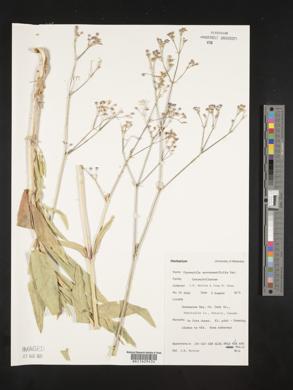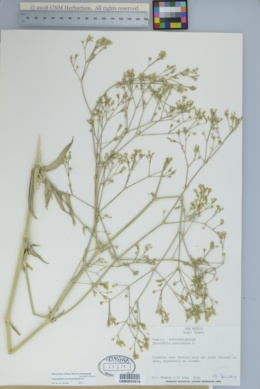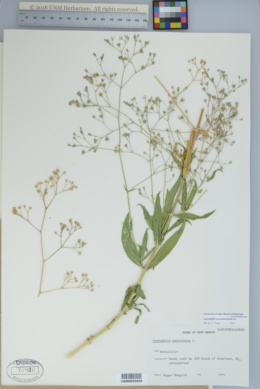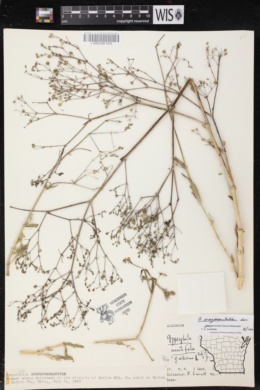Gypsophila scorzonerifolia
|
|
|
|
Family: Caryophyllaceae
Garden Baby's-Breath, more...glandular baby's-breath
[Gypsophila acorzonerifolia Ser.] |
Plants perennial. Stems ± erect, simple or few-branched proximal to inflorescence, 5-20 dm, proximally glabrous, distally glandular-puberulent. Leaves basal and cauline, bases clasping; blade oblong-lanceolate to nar-rowly ovate, larger leaves 2-15 cm × 7-22(-35) mm, glaucous, apex obtuse to acute. Pedicels 1-12 mm, glandular-puberulent. Flowers: calyx 2.5-4 mm, lobes glandular-puberulent, apex obtuse; petals white with pink tinge to light purplish pink (drying darker), 4-6 mm. Capsules globose. Seed coats coarsely tuberculate. 2n = 68 (Europe, introduced population). Flowering summer-fall. Beaches, roadsides, railroad grades, quarries, and other open, calcareous, sandy or rocky, disturbed sites; 0-1700 m; introduced; Alta., B.C., Ont.; Calif., Colo., Conn., Ill., Ind., Mich., Nev., N.Mex., N.Y., Ohio, Utah, Wis., Wyo.; Europe (se; introduced elsewhere in Europe). There is a historic record of Gypsophila scorzonerifolia from Massachusetts collected in 1921. Some Ohio specimens of Gypsophila scorzonerifolia have calyces rather sparsely glandular or appearing to lack glands at maturity, but all of the young flowers have obviously glandular calyces.
Perennial herb with a taproot 0.5 - 2 m tall Stem: more or less upright, unbranched or few-branched, glandular-hairy above, and with a waxy coating (glaucous) below. Leaves: opposite, stalkless, clasping the stem, 2 - 15 cm long, 1 - 2 cm wide, oblong lance-shaped to narrowly egg-shaped with a blunt or pointed tip, with a waxy coating (glaucous). Inflorescence: an open, branched cluster (cyme) of flowers subtended by paired bracts. The bracts are scarious (dry, thin, and membranous). Flowers: white to pale purplish pink. Stalk 1 - 12 mm long, glandular-hairy. Stamens ten. Styles two. Sepals: forming a cup (calyx). Calyx 2.5 - 4 mm long, five-lobed, five-veined, scarious (dry, thin, and membranous), glandular. Lobes with a blunt tip, glandular-hairy. Petals: five, white to pale purplish pink, 4 - 6 mm long. Fruit: a dehiscent capsule (opening by four ascending teeth), spherical. Seeds brownish, compressed, nearly kidney-shaped. Similar species: The similar Gypsophila paniculata differs by having non-clasping leaves that only grow to 1 cm wide. Flowering: July to late September Habitat and ecology: Introduced from Eurasia. An escape from cultivation that is increasing being found along railroads. Occurence in the Chicago region: non-native Etymology: Gypsophila comes from the Greek words gypsos, meaning gypsum, and philos, meaning loving, referring to most species' love of lime. Scorzonerifolia means "having leaves like Scorzonera." The genus name Scorzonera comes from the Old French word scorzon, meaning snake, referring to the belief that the root could cure snakebites. Author: The Morton Arboretum Coarse, diffusely branched perennial, mostly 5-10 dm, glabrous and glaucous below, glandular-hairy above; lvs oblong-lanceolate to ovate, mostly 2-10 נ1-2 cm, obtuse or abruptly acute, clasping at the base; pedicels and cal glandular; cal 2.5-4 mm; pet 4-6 mm, pale purplish-pink or white, drying darker; capsule globose. Native to the lower Volga region in the U.S.S.R., and occasionally intr. in our range, as in Mich. and Ind. Summer. Gleason, Henry A. & Cronquist, Arthur J. 1991. Manual of vascular plants of northeastern United States and adjacent Canada. lxxv + 910 pp. ©The New York Botanical Garden. All rights reserved. Used by permission. From Flora of Indiana (1940) by Charles C. Deam ...... Indiana Coefficient of Conservatism: C = null, non-native Wetland Indicator Status: N/A |












































